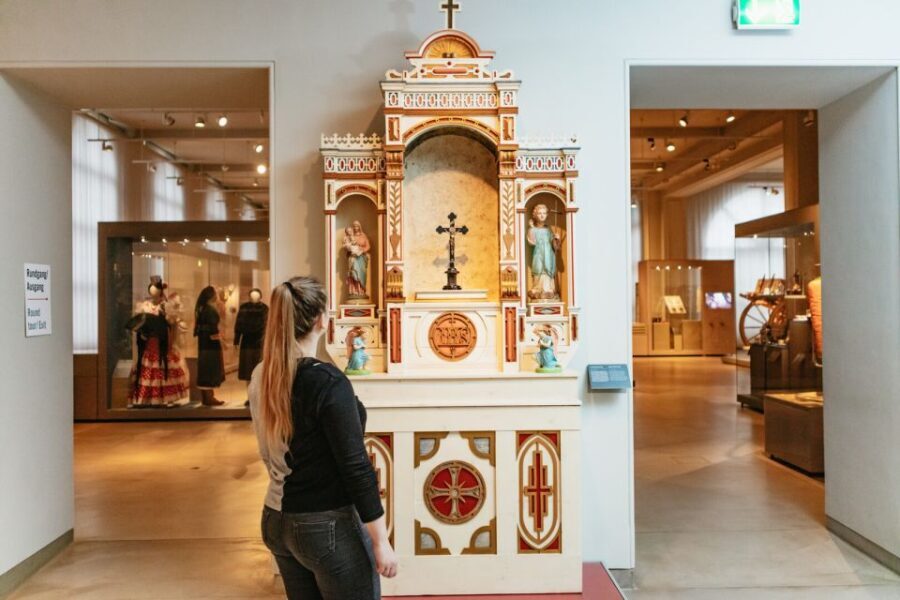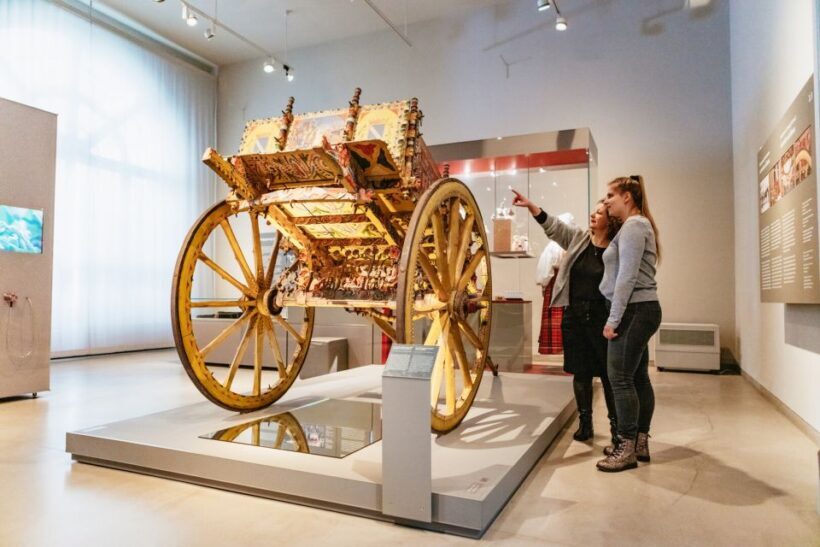Planning a trip to Europe can be thrilling, filled with visions of historic landmarks, delicious cuisine, and world-class museums. As you map out your itinerary, you may find yourself wondering about one crucial detail: “Are backpacks allowed in European museums?”
This might seem like a minor concern, but imagine the inconvenience of reaching a museum’s entrance only to be told that your backpack is not permitted inside. It could disrupt your plans and add unnecessary stress to your day. You deserve a seamless and enjoyable experience while immersing yourself in the cultural treasures of Europe.
To help ensure your museum visits are as smooth as possible, let’s dive into what you need to know about backpacks and museum policies across Europe.

Credit: theabroadguide.com
Backpack Policies Across Europe
Backpack rules in European museums vary widely. Many places want to protect artworks and keep visitors safe. Some museums allow small bags, while others ban backpacks altogether. Knowing these rules helps you plan your visit without hassle.
General Rules In Major Museums
Most big museums limit backpack size. Large backpacks often must be left in lockers or cloakrooms. Staff may ask visitors to carry bags in front of them. Security checks are common to prevent damage or theft. Bringing a small bag is usually fine, but always check museum guidelines.
Country-specific Regulations
Each country sets its own museum rules. In France, many museums ban backpacks inside galleries. Italy often requires backpacks to be stored at the entrance. Germany may allow small backpacks but with strict size limits. Spain usually permits bags but may require them to be worn on the front. Checking the local rules can save time.
Exceptions And Special Cases
Some museums allow backpacks for special needs. Visitors with medical equipment or baby supplies often get exceptions. Museums with outdoor spaces may have looser rules. Temporary exhibitions sometimes change the usual policies. Always ask staff about your situation before entering.

Credit: www.travelersuniverse.com
Reasons For Restrictions
European museums often restrict backpacks for several important reasons. These rules are not meant to inconvenience you but to create a safer and more enjoyable experience for everyone. Understanding these reasons can help you prepare better and respect the museum environment.
Protecting Art And Artifacts
Backpacks can accidentally bump into delicate artworks or displays, causing damage that might not be visible immediately. Museums house centuries-old pieces that require careful handling and protection. Even a small scratch or stain from a bag could ruin priceless artifacts forever.
Imagine walking through a narrow gallery with a large backpack—it’s easy to accidentally hit a fragile sculpture or touch a painting without realizing it. By limiting backpacks, museums lower the risk of such accidents and preserve their collections for future visitors like you.
Visitor Safety Concerns
Large backpacks can obstruct walkways and emergency exits, creating hazards during crowded times or emergencies. They might also cause tripping accidents, especially in busy or dimly lit areas. Your safety and that of others is a top priority for museums.
Think about how difficult it would be to quickly move through a packed room if everyone carried bulky bags. Restrictions on backpacks ensure clear paths and reduce the chances of accidents, making your visit safer and more comfortable.
Space And Crowd Management
Museums often have limited space, and large bags take up extra room that could block displays or other visitors’ views. Managing crowds is essential to keep the flow smooth and avoid congestion in popular exhibits. Backpacks can slow down movement and make it harder for you and others to enjoy the art fully.
Have you ever found yourself stuck behind someone struggling with a bulky bag in a crowded gallery? These restrictions help keep the space open and accessible, so you can focus on the experience without distractions or delays.
Alternatives To Carrying Backpacks
Carrying backpacks inside European museums can be tricky. Many museums restrict backpacks to protect art and keep pathways clear. Visitors need smart alternatives to carry essentials without hassle. Several options exist to keep belongings safe and enjoy the visit freely.
Onsite Locker Facilities
Many museums offer lockers near the entrance. These lockers keep bags secure while you explore. Lockers usually require a small fee or a coin deposit. They come in various sizes to fit different bags. Using lockers means you won’t worry about your belongings during the visit.
Bag Check Services
Some museums provide bag check counters. Staff members hold your backpacks safely until you leave. This service is often free or low cost. Bag check areas are supervised for extra security. This option works well if you carry larger bags or valuables.
Using Smaller Bags Or Pouches
Switch to smaller bags for museum visits. Compact bags or pouches hold essentials like wallets, phones, and keys. They fit easily under a coat or in front pockets. Smaller bags cause less obstruction in crowded spaces. This choice helps follow museum rules and stay comfortable.
Preparing For Your Museum Visit
Preparing for your museum visit in Europe means more than just picking a day and showing up. Knowing the rules about backpacks and what to bring can save you from last-minute hassles. It’s about making your experience smooth, enjoyable, and focused on the art or history around you.
Checking Museum Websites
Before you pack your bag, visit the official museum website. Many museums clearly state their rules about backpacks and bags. Some allow small backpacks, while others require you to use lockers or cloakrooms.
Look for details on size limits and security checks. This can save you time and avoid disappointment at the entrance. Have you ever been stuck in a long line because your bag wasn’t allowed? Checking ahead prevents that.
Packing Essentials Wisely
Think about what you really need to bring. A bulky backpack might not be welcome, but a small crossbody or a tote bag usually is. Pack light to avoid stress and keep your hands free for cameras or guidebooks.
Include only essentials like your ID, wallet, phone, and maybe a water bottle if allowed. Avoid items like umbrellas or large shopping bags if the museum bans them. Carrying less helps you move quickly and enjoy more.
Timing Your Visit To Avoid Crowds
Visiting at off-peak hours changes your experience completely. Early mornings or late afternoons are often quieter. This means less waiting and more time to admire exhibits without distractions.
Check if the museum has special days with free or discounted entry—these times can be packed. Have you noticed how much more you see when there’s space around you? Planning your visit carefully makes a big difference.
Tips For Managing Backpacks
Managing your backpack effectively can make your visit to European museums smoother and more enjoyable. Knowing when backpacks are allowed and how to handle them properly helps you avoid hassle at entrances and keeps artworks safe. Here are practical tips to help you navigate museum rules and show respect for the space.
When Backpacks Are Allowed
Many European museums restrict backpacks to protect fragile exhibits. Smaller backpacks or bags are often permitted, especially if they fit under a seat or are carried in front. Some museums provide lockers or cloakrooms where you can store larger backpacks for free or a small fee.
Check the museum’s website before your visit to see their specific rules. Have you ever been surprised by a sudden backpack ban at a museum? Planning ahead prevents that stress.
How To Wear Backpacks Safely
If backpacks are allowed inside, wear them on your front in crowded galleries. This reduces the chance of accidentally brushing against art or other visitors. Adjust straps to keep your bag snug and close to your body for better control.
Consider a lightweight, compact backpack with padded straps to improve comfort during long tours. You might also want to carry only essentials to keep your backpack light. How much do you really need when exploring a museum?
Respecting Museum Etiquette
Respecting museum etiquette means more than just following rules; it shows care for the space and other visitors. Avoid placing backpacks on benches or floors where they could block pathways or damage floors. Always use designated areas for bags when available.
When in doubt, ask staff for guidance on backpack storage or carrying. Your awareness helps protect priceless art and creates a positive experience for everyone. What small changes in your behavior could improve your next museum visit?
Impact On Visitor Experience
Carrying backpacks in European museums can significantly influence how you experience the visit. Your comfort, ability to interact with exhibits, and even the quality of your photos depend on whether backpacks are allowed or need to be checked in. Understanding these impacts helps you prepare better and enjoy the art and history on display.
Ease Of Movement
Backpacks can be bulky and cumbersome in crowded museum spaces. Navigating narrow corridors or staying close to delicate exhibits becomes challenging when you’re carrying a large bag.
Many museums restrict backpacks to prevent accidents like bumping into displays or other visitors. Without the extra load, you can move more freely, focus on the art, and avoid the stress of constantly adjusting your bag.
Think about your last museum visit—did you feel restricted by what you were carrying? Traveling light often makes the entire experience smoother and more enjoyable.
Photographing Exhibits
Photographing art or artifacts is a popular way to capture memories. However, large backpacks can block your view or limit your ability to get close to the exhibits.
Some museums require you to store backpacks before entering photo zones to avoid accidental damage or shadows on displays. This rule, while inconvenient, helps ensure better photo quality and protects the exhibits.
Have you ever struggled to take a clear picture because of your gear? Leaving your backpack behind or using a smaller bag can give you better angles and a clearer shot every time.
Engagement With Displays
Interacting with interactive displays or touchscreens is easier when you’re not weighed down. A heavy backpack can distract you or make you hesitant to lean in and explore.
Without a backpack, you’re more likely to fully engage—reading plaques, trying hands-on activities, or joining guided tours without fuss.
Ask yourself: does carrying a backpack help or hinder your curiosity? Often, shedding the extra load lets you dive deeper into the experience museums want to offer.

Credit: www.travelersuniverse.com
Frequently Asked Questions
Are Backpacks Allowed Inside European Museums?
Most European museums restrict backpacks for security and preservation reasons. Visitors usually must store them in lockers or cloakrooms. Small bags may be allowed but check specific museum rules before visiting.
Why Do Museums Restrict Backpacks In Europe?
Backpacks can damage exhibits or block pathways. Restrictions help protect artworks and ensure visitor safety. Museums aim to provide a comfortable experience by controlling bag sizes and types.
Can I Carry A Small Backpack In European Museums?
Some museums permit small backpacks if they fit under seats or in designated areas. Always verify the museum’s bag policy online to avoid issues at entry.
Where Can I Store My Backpack In European Museums?
Many museums offer free or paid lockers and cloakrooms for backpacks. Use these facilities to securely store your bag and enjoy the exhibits without hassle.
Conclusion
Backpacks are often restricted in many European museums. Visitors usually need to use lockers or carry small bags. Rules vary by museum, so check before your visit. Carrying a backpack may slow you down or block others. Museums want to protect artwork and keep visitors safe.
Planning ahead helps you enjoy exhibits without hassle. Small bags or pockets work best inside museums. Following these tips makes your museum trip smooth and fun.





